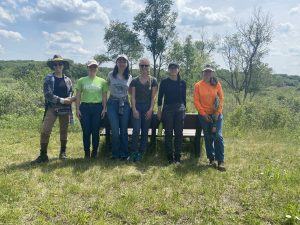
Let the summer begin! TLC’s CLIP program is underway
Last week TLC launched its CLIP internship program, which is designed to be a hands-on learning experience designed to empower participants with the knowledge and skills required to navigate the field of conservation as a professional.
June 1 marked day one of CLIP, after introductions, began orientation, paperwork and a tour of TLC’s headquarters at Hennen Conservation Area. While touring the conservation easement at Hennen, CLIPterns were given their first GIS assignment and used Collector (by ArcGIS) to mark points along the trail system. Lunch brought words from our Executive Director, Lisa Haderlein, about the history of TLC and the various ways that we preserve and work with the land. One takeaway that none of us will forget is that land preservation tends to be complicated and can take a long time (possibly years). Following lunch we visited several TLC sites including: Spring Hollow, Wolf Oak Woods, York Conservation Easement, Crowley Oaks and Apple Creek Conservation Easement. This is where botanizing began as the CLIPterns were introduced to more than 20 native plants (and a few non-natives) … just as a start.

Wednesday morning, or Day 2, began with a staff meeting at Yonder Prairie, where interns learned more about the complicated world of land preservation (Lisa explained the history of preserving Yonder and surrounding lands). After the meeting we went to check the turtle traps at one of our sites; we found two painted turtles and one snapper.
Following lunch the CLIPsters learned everything they need to know about field equipment and herbicide use and safety. Throughout the summer, everyone will have the opportunity to use multiple types of tools (from manual to mechanical) and practice several forms of herbicide application. The day ended with adding several species to our “plant book” where we fix plant samples from the field onto paper with handwritten notes to describe how to identify the specimen.

Thursday morning marked the first volunteer workday of the season, which took place at Crowley Oaks. At lunch the CLIPterns scarcely had an appetite due to the amount of pie that was consumed on break (special thanks to the volunteers). As you can imagine, the interns and volunteers are getting along just fine. Once everyone was finished with their “small lunch,” the CLIPterns got their first hands-on experience with backpack sprayers, which we used to spray a notorious invasive (Reed Canary Grass). Although conditions were hot (paired with uneven ground and the occasional tripping hazard) and the day was long everyone’s dedication to the mission remained strong.
It’s finally Friday!!!! First off was a Project Quercus tree planting with Dave Zeiger; showing the CLIPsters another side of the restoration game … planting natives! Everyone worked in pairs and even got to name the trees; nine oaks in total, were planted. After we had lunch on the Zeiger household deck, we went to check out a pollinator garden at Harrison School in Wonder Lake; a garden installed by Small Waters (whom we will spend a day and a half with later this summer). Next was a visit to the McHenry County Recorder’s office to record TLC’s newest conservation easement (a small parcel near the border of Wisconsin).


I explained that all of the land we preserve at TLC is documented and recorded in this way and to no one’s surprise, I revealed that protecting this particular piece of land was YEARS in the making. Finally, we went back to headquarters where interns were assigned two native plants to learn about and present to their peers. The day ended with a journal entry (every CLIPtern is keeping close records of daily activities, protocols, professional contacts, etc.) and the assignment of our first discussion article by Frederick E. Clements titled “Nature and Structure of the Climax.”
All in all, I was so happy to finally meet everyone in person and to finally start putting CLIP into real action. Keep your eyes out for more updates from all of us at CLIP!
If you’d like to make a donation to help support the CLIP program, click here. Thank you!